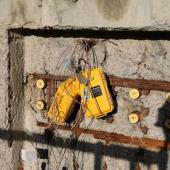Wind tunnel testing for M40 concrete bridge barriers
Plans for a new central reservation barrier that will increase safety and reduce maintenance on the M4 Prince of Wales bridge have been modelled by National Highways, thanks to the use of a wind tunnel.
While replacing a steel barrier with a concrete central reservation is normally straightforward, the 5,12m-long bridge provided a unique challenge due to the environment of this "iconic" bridge.
National Highways needed to understand the impacts of installing a concrete barrier, particularly on the 948m cable-stay section of the bridge, which is subject to strong winds and a challenging marine environment on the Severn Estuary.

To ensure a concrete barrier is right for the structure and users of the road, National Highways’ Specialist Bridges Group drove an innovative feasibility study project, aimed at modelling and assessing the aerodynamic stability implications of installing a new concrete barrier.
This approach as part of the project development stage was pivotal because failure to correctly factor and address the impact of a concrete barrier could lead to changes in bridge behaviour during windy conditions.
Matthew Jones, asset needs and programme development manager, Specialist Bridges Group, said: “We are constantly exploring new innovative ways to design, build and maintain our roads and are committed to making them safer. We believe that embracing innovation and working closely with engineering specialists is the path to more efficient and safer projects.
“By undertaking modelling, trials and tests like these, we can ensure we’re making the right changes to see significant long-term benefits and improve the experience of our roads for motorists.
“Upgrading these barriers will improve journeys and significantly reduce the risk of vehicles crossing over from one carriageway to another, improving safety and reducing the duration of incident-related congestion.”

The project involved undertaking innovative wind testing techniques with specialist consultant RWDI, which also has experience with other well-known bridges across the globe, such as the Golden Gate Bridge.
This allowed the proposed central reservation barrier design to be tested under different wind conditions and scenarios, whilst factoring in the specific dimensions and cross-section profile of the Prince of Wales Bridge.
Taking place in Canada, National Highways was able to virtually observe the effects of wind on the bridge model in a controlled and recorded bridge tunnel environment. It was determined that ‘the bridge with the new solid median will behave virtually identically to the bridge in its current state’, allowing steps to be taken towards onsite construction in 2025/26.
The proposed concrete barrier is a significant improvement compared to the existing metal one and will reduce the risk of vehicles crossing over from one carriageway to another, improving safety and reducing the likelihood of incident-related congestion.
In addition to being more maintenance-friendly, this concrete barrier will last twice as long as the original metal barrier, with far less need for closures for routine repairs.
Patrick Madden, designer for Amey, added: “Upgrading the existing barrier to bring it in line with current standards is vital, and it has a significant impact on maintenance requirements of the barrier.
“The current barrier requires partial closures of the bridge for ongoing maintenance, and these interventions can impact the bridge structure itself as the current barrier is bolted to the deck.
“The proposed barrier will require significantly less maintenance, as it is less prone to damage that requires interventions, and it does not require mechanical fixing to the deck, reducing the impact on the bridge structure when maintenance is required.”
To find out more about the Severn Bridges, visit nationalhighways.co.uk







